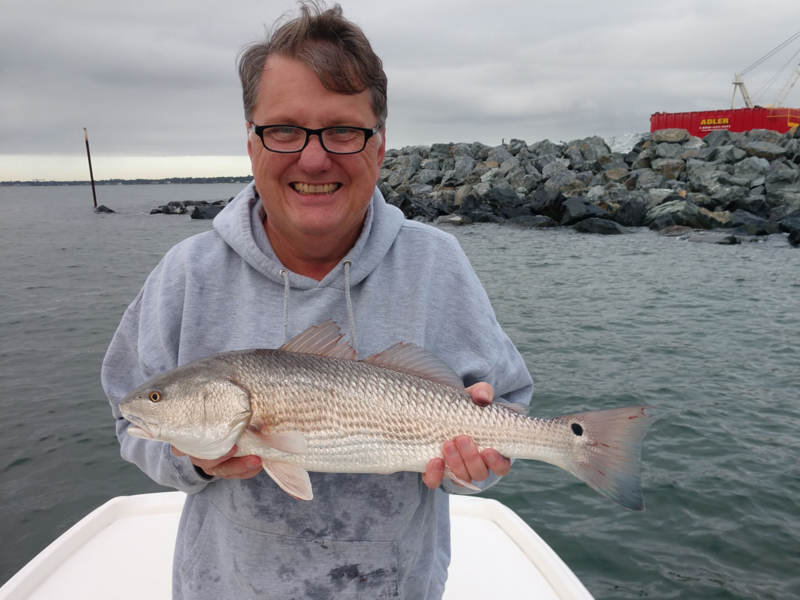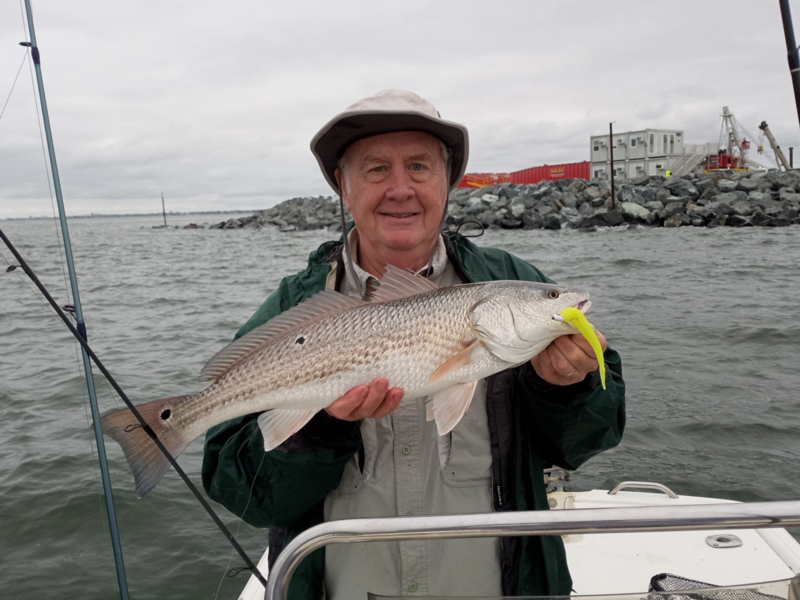You will hear this fish called by many names: red drum, redfish, puppy drum for small ones, and bull redfish for very large ones. When I was young, the old timers in our area referred to them as channel bass. I don’t hear anyone calling them that anymore, but today we’ll focus in on one title of sorts: slot reds. This refers to red drum that fall within the legal limit to keep for the table. Currently in Virginia you are allowed to keep three reds between 18 and 26 inches per angler, per day, and in Maryland you’re allowed one fish between 18 and 27 inches.

No matter what you call them, or whether or not you plan to keep any, red drum are one of the hardest fighting inshore fish around. Once on the hook, even small reds will put up a strong fight. It is this fighting ability that makes them so popular.
These fish are part of a larger family that includes spot, croaker, black drum, as well as gray trout and spotted sea trout (speckled trout). These are all schooling fish, which means that where you catch one, you’re likely to find more. The “drum” in their name refers to the drumming sound made by some members of the family (most notably croakers and black drum).
Tackle for Slot Redfish Fishing
I would stress using good tackle since these fish will put any drag system to the test. I use light spinning tackle when targeting slot reds, 6.5- to 7-foot rods and 10-pound to 20-pound braid. Add about three feet of 20-pound monofilament leader using a modified Albright knot (for a tutorial on tying this knot see “Four Critical Fishing Knots”).
My go to lure is a half-ounce leadhead jig with a three or four-inch soft plastic tail. I use a large variety of plastics, but the one I use the most is a Gulp! Swimming Mullet in white or chartreuse. Why don’t I use live bait or cut bait? Well, many people do and I have caught slot reds on bait. But, for some reason I always do better with artificials. This is also true for speckled trout — which I am usually targeting at the same time with the same gear, along with the reds.
If you’re going to use bait for reds, a small live baitfish like a spot hooked through the lips using a 3/0 to 5/0 circle hook is a good offering. Place a small sliding sinker on the main line above the leader to keep the bait near the bottom. Some anglers also like to use shrimp.

Where To Find Slot Reds in the Way South Zone
During the summer and fall, reds will show up near structure in water up to about 20 feet deep. Structure may be in the form of docks, which are great places to target them inside of Lynnhaven or Rudee Inlets. Other similar inlets near where you live may also hold fish. Cast the jig up under the dock, let it sink, and begin your retrieve.
I often do well anchored or drifting along the sides of the first or second island of the Chesapeake Bay Bridge Tunnel (CBBT) in late fall or early summer. Sometimes they are right up in the rocks, and at other times they are swimming around in big schools, anywhere from the surface to the bottom. Another favorite location of mine is at the Hampton Roads Bridge Tunnel (HRBT). This area is currently torn up with the expansion project, but we still managed to find some nice slot reds at the HRBT last fall. Look for them on the tunnel end of the island on the Hampton side. Just about any bridge may hold slot reds. The fish will usually hold very close to the structure. Early in the year they may also be caught from beaches as they migrate north.
For some ideas on where to catch puppy drum farther north, see “Puppy Love."
How To Tempt Slot Redfish into Biting
If you’re fishing on shore, try fan-casting in all directions. Allow the jig to hit the bottom, and then begin a retrieve with a jig-jig-stop action. Jig by raising the rod tip a couple of times and then allow the lure to fall back to the bottom. Reel in a few feet and repeat. Keep this up until the lure is almost all the way back. This technique will also work for many other species such as speckled trout, bluefish, and flounder.
You will sometimes see schools of reds swimming a few feet below the surface. When this is the case, try to cast in front of them and work the lure slowly. If you happen upon a school like this while on a boat, don’t run over the school with a boat because they will scatter. Most of the time, however, you will not be able to see the school because they will be near the bottom. I prefer to anchor my boat in a likely location and make casts in all directions.
If you’re using live bait from an anchored boat or from shore, cast it out, let it fall to the bottom, and put the rod in a holder. If the fish grabs the bait, it will hook itself and you can reel it in. You may leave a live bait out while working a jig on another outfit, too.
Choosing the Right Fishing Rods and Gear for Redfish
Spinning vs. Baitcasting – this will be dictated by the type of reel you are using. Spinning reels hang below the rod. Baitcasting (or conventional) reels connect on the top side of the rod. If you are starting from scratch, a spinning outfit is easier to master. Definitely choose a graphite rod for maximum sensitivity.
Rod length – Longer rods will cast a small lure a greater distance than shorter rods. Most lightweight spinning rods are from six feet to seven and a half feet long. With spinning gear, match it up with a 2000 to 2500 size reel.
Lure and Line size – Rods will indicate what weight of lure and what size line works best for them. These numbers are found written on the rod just above the reel seat. Choose a rod that will match the size lures and line you plan to use. One mistake a lot of people make is using a line that’s too heavy for the rod and reel they are fishing.
Weight and Action ratings – You will see two other types of ratings on the rod. One will determine the weight or power using a scale of “ultra-light” to “extra-heavy”. Most folks use a medium or medium-heavy weight for inshore saltwater fishing. The other rating refers to the action of the rod. This is usually indicated by a scale of “slow” to “extra-fast”. Basically, this refers to where the rod will bend under pressure. A slow rod bends somewhere in the middle, and an extra-fast rod bends near the tip. Most people fishing jigs prefer a fast or extra-fast rod.
-By Chuck Harrison